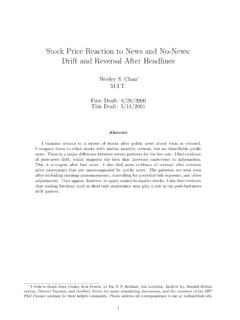Transcription of UNDERSTANDING TRACTOR-TRAILER PERFORMANCE
1 UNDERSTANDINGTRACTOR- trailer PERFORMANCEThis document is written for educational purposes only. The TRACTOR-TRAILER , power train, accessories, PERFORMANCE and fuel economy depicted are for illustration only and do not reflect the actual performanceof any particular vehicle PERFORMANCE and fuel economy requires a basic knowledge of the many variablesthat affect the operation of a Class 8 TRACTOR-TRAILER . Some of the most significant factors affecting fueleconomy and PERFORMANCE are: Driver (Operator) Route selection Vehicle speed Frontal area and Aerodynamic properties Grade (Hill) Engine Cooling requirements (Fan Horsepower Demand) Climate (Ambient Conditions) Fuel API Gravity GCW (Gross Combination Weight) Idle time Auxiliary Power Unit (APU) Tires Gearing (Spec ing) Transmission Other Factors Customer Factors Compression Brake (C11, C13, and C15 Engines with ACERT Technology)DRIVER (OPERATOR)The most significant variable affecting fuel economy is the driver.
2 The driver controls the vehicle speed,acceleration rate, brake usage (service, compression, or exhaust), cruise control usage, shiftingtechnique, trailer gap setting, idle time, tire inflation pressure, and more. It is not uncommon for fleetswith identicallyspec ed trucks to experience as much as 25% ( vs. MPG) difference in fuelconsumption between the best and the worst SELECTIOND riving in congested areas increases fuel consumption. Traveling 15% of the total miles on congested roadsresults in approximately an 8% increase in fuel consumption. Traveling 25% of the total miles on congestedroads results in approximately a 15% increase in fuel economy can improve while driving on 2-lane highways providing that the trip distance is shorter andthat the driver has the discipline to drive at a slower speed to maintain a steady speed. Slower speed andsteady speed will reduce fuel consumption due to the lower horsepower demand on the heavy vehicle like a TRACTOR-TRAILER can coast a long distance without throttle diesel engine, mechanically or electronically controlled, does not consume fuel when coasting since fuelis not injected into the cylinders.
3 Minimize vehicle speed fluctuation. Use the cruise control, when safe to doso, to maintain a steady vehicle the following discussion, four (4) different vehicles mentioned in Figure 1are 1. Vehicle Description TypeVehicleHP / TorqueFrontal AreaCoefficient GCW (lb)TypeEngine(lb-ft)(ft2)of Drag (Cd)AutomobileGas250 / ,250 Tractor-TrailerVanC15550 / 1850108 ( ' ') ,000 Flat-bed87 ( ' ') ,000C15550 / 1850108 ( ' ') REFERENCE 3 Route SelectionVEHICLE SPEEDV ehicle speed is a very important factor affecting fuel economy. A general rule of thumb to remember isthat fuel economy will change approximately MPG for every 1 MPH above 55 MPH. Decreasing thevehicle speed from 70 MPH to 65 MPH can improve fuel mileage by approximately mile per vehicle speed places a higher horsepower demand on the engine. When horsepower demandincreases, fuel consumption 2shows Wheel Demand Horsepower vs.
4 Speed, on a flat, smooth surface and on a calm day (nowind) for an automobile and three tractor-trailers described in Figure 2. Wheel Demand HP vs. MPH Flat, Smooth Surface, No WindFRONTAL AREA AND AERODYNAMIC PROPERTIESThe TRACTOR-TRAILER aerodynamic package is a very large contributor to a vehicle fuel economy industry trend is toward more aerodynamic tractors while the widely used Van / Refer trailers areundergoing aerodynamic scrutiny. Figure 3provides a breakdown of Aerodynamic Resistance horsepower and Rolling Resistance , they represent the Wheel Demand horsepower needed to move a vehicle at a given speed, ona flat, smooth surface on a calm day (no wind). Data is given for the automobile and the three tractor-trailersdescribed in Figure SpeedAerodynamicsMPHW heel Demand HP vs. MPH(Flat, Smooth Surface / No Wind)Wheel Demand HP50556065707580850501001502002503003504 00450500550600 Van / ' ' Cd / 80,000 lbLowboy / ' ' Cd / 140,000 lbFlat-bed / ' ' Cd / 80,000 lbAutomobile Cd / 4,250 lbFigure 3.
5 Wheel Demand HP vs. MPH Flat, Smooth Surface, No WindVehicle Aerodynamic / RollingTotal Wheel DescriptionAir ResistanceResistanceDemandMPHGVW (lb)HPHPHPA utomobile 4,2501151655 Van 80,0007496170 Flat-bed 80,0008096176 Lowboy 140,000124167291 Automobile 4, 80,00096108204 Flat-bed 80,000103108211 Lowboy 140,000160188348 Automobile 4, 80,000122121243 Flat-bed 80,000131121252 Lowboy 140,000204211415 Automobile 4,2502373070 Van 80,000153134287 Flat-bed 80,000164134298 Lowboy 140,000254234488 Automobile 4, 80,000188148336 Flat-bed 80,000202148350 Lowboy 140,000313259572 Automobile 4,2503494380 Van 80,000228163391 Flat-bed 80,000245163408 Lowboy 140,000379284663 QUICK REFERENCE 5 AerodynamicsThe 80,000-pound TRACTOR-TRAILER Rolling Resistance demand horsepower is approximately nineteen (19) timesgreater than that of the TRACTOR-TRAILER has a frontal area that is approximately three and one-half ( ) times larger thanan automobile.
6 The larger frontal area combined with a greater Coefficient of drag ( Cd) creates anaerodynamic drag that is approximately seven (7) times greater than that of an automobile, and placesa much higher horsepower demand on the engine to overcome air Coefficient of drag (Cd) with a range of to , that is the aerodynamic properties of some of themost aerodynamic tractor-trailers, is considerably higher than that of the modern automobile with to Coefficient of 55 MPH, the Aerodynamic Resistance horsepower of a typical TRACTOR-TRAILER becomes more significantthan the Rolling Resistance horsepower needed to overcome Air Resistance increases as a cubic function of vehicle means that when vehicle speed doubles, horsepower requirement is eight (8) times at the 80,000-pound TRACTOR-TRAILER , when speed increases from 65 to 70 MPH, the engine mustdevelop an additional 45 horsepower to meet the Total Wheel Demand horsepower.
7 This is a significant18% increase! Aerodynamic Resistance horsepower accounts for 32 horsepower and represents 71%of the a rule of thumb, fuel consumption increases approximately MPG for every 1 MPH above 55 MPH,assuming that the vehicle is properly spec ed and the transmission is in top gear. In other words, increasingvehicle speed from 65 MPH to 70 MPH increases fuel consumption and reduces the fuel mileage by aerodynamic differences between two tractors , one equipped with all the fairings and the otherwithout fairings, coupled to a Dry Van can amount to MPG or a 9% TRACTOR-TRAILER gap for a high cube trailer (Dry Van, Reefer) is another factor affecting 6-foot gap can represent a penalty or MPG. Testing by a major OEM has shown that for every12 inches of trailer gap, the fuel mileage changes approximately 1%.The TRACTOR-TRAILER configuration can represent up to MPG or a 30% difference in fuel mileage is based on a comparison between an aerodynamic TRACTOR-TRAILER (Dry Van) with an 18" gap and aCar Hauler, both with 80,000 lb speed increases, tractor-trailers with lower aerodynamic drag will experience a smaller fuel mileagepenalty than vehicles with poorer aerodynamic (HILL)On a grade, the Wheel Demand horsepower increases significantly as vehicle weight 4shows Wheel Demand Horsepower vs.
8 MPH, on a 3% grade and on a calm day (no wind) for theautomobile and the three (3) TRACTOR-TRAILER combinations described in Figure 4. Wheel Demand HP vs. MPH 3% Grade, Smooth Surface, No WindOn a grade, the total of the horsepower required to overcome Air Resistance, Rolling Resistance, andGrade Resistance constitute the Wheel Demand horsepower. This horsepower demand increasesdramatically with vehicle weight and 5provides a breakdown of Aerodynamic Resistance horsepower, Rolling Resistance horsepowerand Grade Resistance horsepower. Combined, they represent the Wheel Demand horsepower needed tomove a vehicle at a given speed, on a 3% grade on a calm day (no wind). Data is given for the automobileand the three (3) TRACTOR-TRAILER combinations described in Figure that Grade Resistance horsepower is by far the highest contributor to the Wheel Demand REFERENCE 7 GradeWheel Demand HP vs.
9 MPH 3% Grade(Smooth Surface / No Wind)600 Wheel Demand HP55050045040035030025020015010050025303 54045505560 MPHA utomobile 4,250 lbTractor- trailer 80,000 lbTractor- trailer 140,000 lbFigure 5. Wheel Demand HP vs. MPH 3% Grade, Smooth Surface, No WindTRACTOR-TRAILERPERFORMANCEGUIDE8 GradeAerodynamic / RollingGradeTotal Wheel VehicleAir COOLING REQUIREMENTS (FAN HORSEPOWER DEMAND)Tractor-trailers and trucks powered by Caterpillar diesel engines are generally equipped with an ON / OFFfan. Ram air through the various heat exchangers is normally sufficient to handle the cooling requirementsand the fan is usually operating less than 5% of the time. These larger cooling fans, when operational,require more horsepower from the engine to handle the greater cooling requirements. When the fan isnot running, it requires a minimum amount of horsepower from the smaller units at the low end of the horsepower spectrum can be equipped with a viscous viscous fan rotates whenever the engine is running.
10 The faster the engine runs, the faster thefan turns, increasing the horsepower demand on the cooling fan parasitic horsepower not only consumes fuel, it also reduces the reserve horsepoweravailable at the drive wheels to accelerate the TRACTOR-TRAILER or maintain cruise speed on an uphill 6shows a typical engine cooling fan demand horsepower for a C7 or C9 powered truck and a C13or C15 powered truck or TRACTOR-TRAILER with the radiator cooling fan ON .Figure 6. Engine Cooling Fan Demand Horsepower vs. Fan RPMNOTE:Fan RPM and Engine RPM are often different. The Original Equipment Manufacturer (OEM) designsthe cooling system configuration. Figures 6and 7depict an engine cooling fan turning at enginespeed ( :1 Ratio).Figure 7shows the horsepower and torque at different RPM for the C15 Caterpillar diesel engine rated at550 horsepower and 1850 lb-ft of torque.






